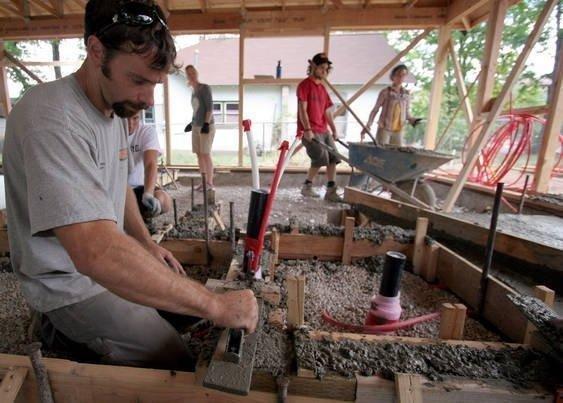When Nancy Morlock and boyfriend Eric Boxrud were ready to give up the communal living that tends to go hand in hand with being a mountain bike guide in Moab, their search for a place of their own yielded results that were less than appealing.
“Houses were priced out of our income level,” said Morlock, a guide for Moab Cyclery and Escape Adventures.
“What Eric and I found was this little piece of property, and it had a single-wide trailer on it,” she said. “We were going to settle for living in that.
“We could have done it, but it would have been way more of a struggle,” Morlock added. “We would have been in over our heads.”
Enter Community Rebuilds — a nonprofit organization that seeks to improve workforce housing in Moab through the construction of affordable energy-efficient homes. The group hauled off Morlock and Boxrud’s pink, single-wide trailer and replaced it with a light green home that includes more than a few unique features.
“We build passive solar straw bale homes for qualifying families who receive a low-interest loan through USDA Rural Development,” said Community Rebuilds founder and executive director Emily Niehaus.
Niehaus, who has a master’s degree in social work and experience as a loan officer, said she first got the idea for Community Rebuilds in 2003. That was two years before the Southeastern Utah Association of Governments conducted a housing study that showed just how dire the affordable housing situation was in Moab.
“(The study) showed that 35 percent of the housing stock in Moab was considered dilapidated or unacceptable,” Niehaus said. “The majority of the homes are pre-1976 manufactured homes.”
Many of those manufactured homes had been brought to town during the uranium boom, which began in the 1950s. Their age and condition often made them the only affordable option for the folks who “run the machine” that keeps Moab’s tourism industry alive.
“Bike guides, bike mechanics, river guides, full-time but seasonal Park Service employees, those are the people that are applying for (Community Rebuilds) homes and qualifying,” Niehaus said.
The floor plan for those homes is relatively simple: three bedrooms, two bathrooms and less than 1,000 square feet. And the people who build them are all interns who receive a food stipend and a place to stay during the four months it takes for construction.
Eric Plourde, left, an instructor and builder with Community Rebuilds, works on the nonprofit organization’s fourth house in Moab, Utah on Aug. 30, 2012. Community Rebuilds _ a nonprofit organization that seeks to improve workforce housing in Moab through the construction of affordable energy-efficient homes. (AP Photo/The Deseret News, Geoff Liesik) SALT LAKE TRIBUNE OUT; PROVO DAILY HERALD OUT; MAGS OUT “We’re recruiting students from all over the world that have a simple desire to learn how to build a straw bale home from foundation to finish,” Niehaus said.
Eric Plourde, one of the program’s two instructors, said the interns learn everything from basic carpentry to building super-insulated walls with straw bales to laying an adobe floor, which contains radiant heat coils but also absorbs warmth from the sun to keep the house at a fairly consistent temperature.
“We’re focusing on energy efficiency (and) sourcing materials locally,” Plourde said, “trying to create less of an impact with our project.”
Of course there are always questions when someone learns that a home is being built with straw bales.
“The first question that people ask about straw bales is, ‘Don’t mice want to live in straw?'” Plourde said. “Straw is not hay. There’s no seed, so mice are not going to eat something that is basically cellulose that’s been bundled.”
The state building code also bars straw bales from being used in load-bearing walls, Plourde said. To comply with that requirement, Community Rebuilds homes are built with post-and-beam construction.
“There’s nothing for the Big Bad Wolf to blow down because it’s totally supported by wood framing, and then the walls are completely encased in with about an inch-and-a-half of earth plaster,” Plourde said.
Community Rebuilds is in the middle of its fourth build in Moab. It plans to build its first home in Durango, Colo., early next year.
The home Morlock and Boxrud live in was the third built by Community Rebuilds since 2010. The couple moved in two months ago and say they’ve cut their power bill by 80 percent, thanks to the way the home is constructed.
“We never dreamed that we’d have something of this quality this soon,” Morlock said. “This just gives us a great head start on the rest of our life.”
Seeing the couple move into a “new, clean, extremely efficient dwelling” is “very rewarding” for the construction crew, Plourde said.
“I come to work every day and love the work that I do,” he said. The Republic
В


